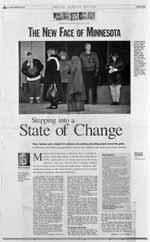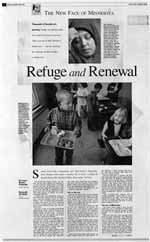Fall 2000
Bringing New Immigrants into the Debate
By Pat Ford
Pew Center
The traditional picture of Minnesota as the land of earnest, fair-haired Norwegians and Swedes has been cemented by humorist Garrison Keillor through his nationally broadcast radio show, “A Prairie Home Companion.” So a visit to Roosevelt High School in Minneapolis might be a startling revelation. About one-third of the students are Somali teenagers who have immigrated in the last few years.
Of some 40,000 Somalis living in the United States, at least 15,000 live in Minnesota, state demographers say. And no one has been more surprised at this new phenomenon than Minnesotans themselves.
“I think there’s been some apprehension about how profoundly the culture of Minnesota may change in the next few years,” says Kate Parry, the St. Paul Pioneer Press projects editor, who oversaw the series “The New Face of Minnesota” earlier this year.
While Parry and her colleagues were considering how to tackle the subject for readers last winter, the League of Women Voters of Minnesota was working on its own project: A series of discussion groups around the state on the subject of immigration.
“It is stressing school systems and health-care systems and people were getting angry thinking resources should go to people who are already here,” says Susan Anderson, the League’s project director for community circles. “We wanted to get a conversation started before hostilities started.”
The League and the Pioneer Press teamed up for an unusual collaboration that they hope has eased concerns and will affect policy. In February, as the League launched its discussion groups, the Pioneer Press ran a series of articles on new immigrants.
 “The New Face of Minnesota” presented in-depth profiles of the state’s five largest immigrant groups. Each story included lists of resources for readers to learn more, join a discussion, explore their own pasts or reach out to immigrants. And the paper ran what it believes is the largest poll ever conducted across several immigrant groups in their native languages.
“The New Face of Minnesota” presented in-depth profiles of the state’s five largest immigrant groups. Each story included lists of resources for readers to learn more, join a discussion, explore their own pasts or reach out to immigrants. And the paper ran what it believes is the largest poll ever conducted across several immigrant groups in their native languages.
“We wanted to do civic journalism that would bring [immigrants, themselves] into the debate,” says Parry. “Instead of finding out what Minnesotans think of immigrants, we decided to do a poll about what immigrants think of Minnesota. …We can’t find another poll that goes across immigrant groups and gives voice to them the way this does.”
Drawing on Experience
Innovative polling has been a hallmark of Pioneer Press projects since it began experimenting with civic journalism in 1995 with “Safer Cities,” a series on crime and continued through “Across Generations,” about intergenerational conflict and “Poverty Among Us,” about the Twin Cities’ poor.
The paper considered the 1998 “Poverty” project, in particular, a great success because the Pioneer Press itself organized discussion groups and book clubs to engage readers in an active way. With the League already organizing discussion groups, the newspaper this time could focus on reporting the series.
As with previous projects, “The New Face of Minnesota” began with a “retreat” at Parry’s house, where reporters and editors decided how to tackle the subject.
“We talked about how quick the disconnect is between our ancestors’ experience and the new immigrant experience,” says Parry. “We were surprised at how quickly people forget most of us are immigrants somewhere along the line. Our past boils down to holiday cookies you make once a year.
“We decided we should take a look at this partly as a public service, to help reconnect readers with their family’s experience, just to remind people, ‘your grandmother had this experience or your great-grandmother. You’re not so far from this’.”
 With that in mind, the Pioneer Press looked at the four largest current immigration groups – Hmong (from Laos), Somali, Latino and Russian – but also at Germans, the largest immigrant group from a previous generation.
With that in mind, the Pioneer Press looked at the four largest current immigration groups – Hmong (from Laos), Somali, Latino and Russian – but also at Germans, the largest immigrant group from a previous generation.
“When you read what it’s like for immigrants in the 1990’s and then read about German immigrants, it’s shockingly similar,” says Parry. “The Germans met hostility in Minnesota that caused them to submerge their culture. Because of the World Wars, it was dangerous to say you were German.”
Parry says the paper was able to burst the myth that immigrants today get entitlements that earlier generations did without. “In some ways, it was easier (for earlier immigrants),” says Parry. “At one point, immigrants to Minnesota got free farms.”
The story of each group is told largely through the experience of just one family – an attempt, says Parry, to put a human face on immigration statistics.
This proved to be a challenge for several of the reporters who found many new immigrants loathe to draw attention – often with good reason. Many have applied for asylum and, technically, should not be working or moving to different cities while the application is pending. (But they do.) Staff writer Leslie Brooks Suzukamo was frustrated, at first, in his effort to find a Somali family to profile.
 “Nobody knew who I was, from a newspaper they couldn’t read and an institution they didn’t understand very well,” says Suzukamo. “Heck, most Americans don’t understand or trust us.”
“Nobody knew who I was, from a newspaper they couldn’t read and an institution they didn’t understand very well,” says Suzukamo. “Heck, most Americans don’t understand or trust us.”
Suzukamo finally met an ideal candidate in 29-year-old Hani Hussein, a recent arrival from Somalia who fled the civil war with her two young sons but left the rest of her family behind.
“She saw it as an opportunity to explain Somali culture to Minnesotans and to be an ambassador for her community, which I thought was an incredibly brave and far-sighted thing to do,” says Suzukamo.
Hussein told of her perilous flight from strife-torn Mogadishu, her wait in a crowded refugee camp, where she gave birth, and the painful decision to leave her husband behind and gamble on getting asylum here so they could be reunited.
“No family escaped Somalia unscathed, Somalis say. Everyone lost someone in the killings among rival clans that overran the country. Hussein is no exception.
“Her father and older brother … who stayed behind to guard the family store were shot and killed.
“The trauma was so extreme that many Somalis won’t – or can’t – share their grief, sometimes experiencing post-traumatic stress disorders as they hold memories of atrocities deep inside.
“Hussein won’t discuss her family’s tragedies, saying it is enough that her children know that their grandfather and uncle are dead without knowing all the details.
” ‘Which I don’t want to get into because I will get emotional,’ she explains, her voice catching.”
“Considering all the barriers and obstacles they’ve been through and the trauma they’ve endured, they’re doing much better than you’d think,” says Suzukamo, “or than we would do if the situation was reversed.”
Different Ports of Entry
Not all readers got that message from Hussein’s story. There was a smattering of letters and e-mails suggesting immigrants should go back to where they came from. But Parry says there was a greater number of positive responses. She recalls one Somali man who called and said, “When you show your tragedy, you feel a sense of relief because now you feel, ‘They know!’ “
Ruby Lee, a program officer for the St. Paul Foundation, says the series prompted several calls. Her group provides grants to community-based organizations that work with immigrant groups.
“Our money is targeted toward groups that are traditionally overlooked and we were very happy that, as a result of the articles, Somali and Ethiopian and new East African groups called,” says Lee. “We got several copies for our board members. It was very educational. All the data they provided about different immigrant groups is very, very helpful.”
Lee is one of 2,000 Minnesotans from around the state who participated in the League’s discussion groups, which met weekly for six weeks. An immigrant, herself, Lee found the discussion groups helpful, if sometimes heated.
“We encountered many hard times in the discussions, talking about white privilege and people of color. There was a tense atmosphere but it was healthy. People were there because they wanted to find out more about the other person,” says Lee. “And they had a lot of individual impact. Just thinking about what their grandparents went through and somebody had to help them out – so what’s their role with new immigrants? The discussions really motivated people to take action.”
For people who could not take part in discussion groups, the paper tried to provide other ways to get actively involved in the subject. Through its web site, readers were able to explore their own genealogy. And even simple actions like speaking to immigrants were encouraged with phonetic translations of “hello” and “thank you” in the native language of each group profiled.
The poll enabled readers to see what it’s like to be an immigrant in Minnesota, revealing the average age, educational level and English proficiency of each group as well as their opinions about Minnesotans as hosts. Though most immigrants find the state’s residents friendly, few think they understand what life was like in their native country. Most miss home but want to assimilate and are already immersing themselves in local culture.
The biggest problem the poll found, by far, is the language barrier.
In a statewide action forum in April, group members identified 10 areas where they would try to make a difference by providing programs themselves (such as community-based adult English courses) or making recommendations to policy makers.
Parry says the Pioneer Press also believes it can play a role in better covering new immigrant communities on a regular basis, “not just show up at a festival or where there’s crime,” she says.
“Newspapers haven’t always done a good job. Now our staff is literate in these communities and we’ve made a massive source list. The goal was not just to do a finite project but to affect the whole newsroom on how to report on these communities.” www.pioneerplanet.com/immigration/.
